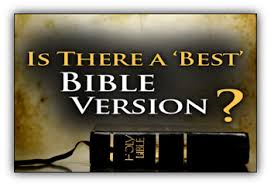SHEPHERD TO
SHEEP
WHICH
VERSION OF THE BIBLE Part II (Comparing versions)
Last time our
emphasis was on the King James Version vs. the modern translations as well as
the importance of accuracy (word for word) and readability. Now let’s do a comparison:
KJV (King
James Version, 1611): Word for word translation. Reading level (RL) 12. Well-loved
and traditional favorite. Difficult to
read due to archaic language. Lovely for memorization.
NKJV (New
King James Version, 1982): Word for word. RL 9. Purpose: to update and
modernize the original KJV but preserve the KJV as much as possible. Maintains poetry of the KJV.
NASB (New
American Standard Bible, pub. 1971/1995): Word for word. RL 11. An update of the (ASV) American
Standard Version into more current English.
Formal, readable, respectable.
ESV (English
Standard Version, 2001): Word for word. RL
8.0. A literal update of the Revised Standard Version (RSV). A good blend of accuracy and
readability.
NIV (New International
Version, 1978): Seeks balance of word for word and thought for thought. RL 7.8. Lively and readable. Widely accepted and adopted by evangelical
believers.
NLT (New
Living Translation, 1996): Seeks balance of word for word and thought for
thought. RL 6.3. Original language
sought but goal was a vibrant contemporary English style.
AMP (Amplified
Bible, 1964): Word for word, amplifying word meanings. RL NA. Brings out more light of Hebrew and
Greek words. Insightful but awkward to
read with brackets.
THE MESSAGE
(MSB, 2002): Thought for thought paraphrase.
RL 4.8. Modern day American speech but holds to the meaning of the
original language. Ultra easy and
relaxed readability.
HCSB (Holman
Christian Standard Bible, 2003): Seeks balance of word for word and thought for
thought. RL 7.5. Published by Lifeway
Christian Resources of the Southern Baptist convention.
I hope this
Bible version comparison is helpful. And
you know it only scratches the surface of so many Bible translations out
there. And every few years another translation
will be published if the pace keeps with the past. But remember the point is to read your Bible
and claim its promises daily!
(2 Tim
3:16-17) All Scripture is given by inspiration of God, and is profitable for
doctrine, for reproof, for correction, for instruction in righteousness, 17 that the man of God may be complete, thoroughly
equipped for every good work.
Louie



